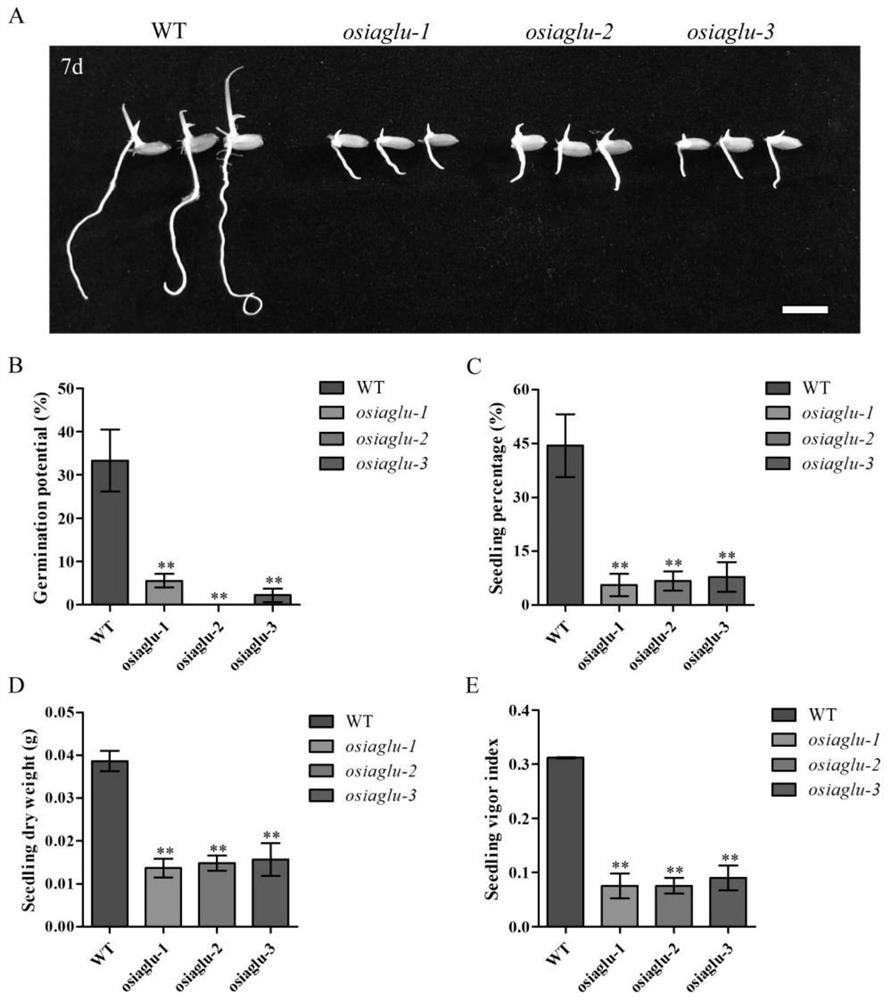Application of Rice Auxin Glycosyltransferase Gene
A technology of glycosyltransferase and auxin, applied in the direction of transferase, application, genetic engineering, etc., can solve the problems of uneven growth of seedlings, affecting crop yield, and unreported application
- Summary
- Abstract
- Description
- Claims
- Application Information
AI Technical Summary
Problems solved by technology
Method used
Image
Examples
Embodiment 1
[0032] Example 1: Gene Cloning
[0033] The sequence of the OsIAGLU gene was cloned by PCR using the japonica rice variety Nipponbare cDNA as a template. The sequence of the upstream primer of PCR is shown in SEQ ID NO.3, and the sequence of the downstream primer is shown in SEQ ID NO.4. The nucleotide sequence and amino acid sequence of the rice OsIAGLU gene are obtained, the nucleotide sequence is shown in SEQ ID NO.1 in the sequence table, and the amino acid sequence is shown in SEQ ID NO.2.
Embodiment 2
[0034] Example 2: Mutant construction
[0035] login to website http: / / www.genome.arizona.edu / crispr / CRISPRsearch.html , screening targets. The target sequence is shown in SEQ ID NO.5, SEQ ID NO.6, and the primers are designed based on the target sequence, and the primer sequences are shown in SEQ ID NO.7 / SEQ ID NO.8, SEQ ID NO.9 / SEQ ID NO.10 . Using pCBC-MT1T2 as a template, PCR amplification with four primers was carried out, and the PCR product was purified and recovered to obtain MT1T2-PCR vector. The pHUE411 vector was digested with BsaI, and the pHUE411+MT1T2-PCR vector was obtained by homologous recombination.
[0036] The obtained pHUE411+MT1T2-PCR vector was transformed into Agrobacterium; the Agrobacterium with the transformation plasmid was transformed into the wild-type japonica rice variety Nipponbare; the PCR amplification product was sequenced, compared with the wild type, and the homozygous mutant was screened. The upstream primers used As shown in SEQ ID ...
Embodiment 3
[0037] Example 3: Phenotype Analysis of Gene Mutants
[0038] Seeds of the successful OsIAGLU CRISPR / Cas9 mutants osiaglu-1, osiaglu-2, and osiaglu-3 constructed in Example 2, and wild-type Nipponbare (WT) rice varieties were used for seed germination experiments. The specific method is as follows: each time repeatedly select 50 healthy and plump seeds, sterilize the surface with 0.1% mercuric chloride solution for 5 minutes, rinse with distilled water for 3 times, dry the surface of the seeds, and place them on a petri dish with two layers of filter paper (diameter 9cm), add 10mL of distilled water, place at 15°C under the conditions of light / darkness for 12h and culture for 7d, and finally count the seedling rate. The experiment was repeated 3 times. The results showed that compared with the control seeds, the mutant seeds germinated slower and the seedling growth was significantly weaker ( figure 1 ). It can be seen that the gene plays an important role in improving the ...
PUM
 Login to View More
Login to View More Abstract
Description
Claims
Application Information
 Login to View More
Login to View More - R&D
- Intellectual Property
- Life Sciences
- Materials
- Tech Scout
- Unparalleled Data Quality
- Higher Quality Content
- 60% Fewer Hallucinations
Browse by: Latest US Patents, China's latest patents, Technical Efficacy Thesaurus, Application Domain, Technology Topic, Popular Technical Reports.
© 2025 PatSnap. All rights reserved.Legal|Privacy policy|Modern Slavery Act Transparency Statement|Sitemap|About US| Contact US: help@patsnap.com


